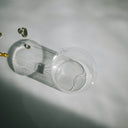Hair loss can be a distressing experience for many individuals, leading to various solutions, including hair transplants. As a result, many people wonder about the best practices for maintaining their newly acquired hair. One common question that arises is whether or not to take finasteride after a hair transplant. This article will explore this topic in depth, providing valuable insights for those considering or having undergone a hair transplant.
Table of content
Do you have to take finasteride after hair transplant?
No, you do not have to take finasteride after a hair transplant, but it is often recommended. Finasteride is a medication that helps prevent further hair loss by blocking the conversion of testosterone to dihydrotestosterone (DHT), a hormone linked to male pattern baldness. While a hair transplant can restore hair in the areas where follicles were transplanted, it does not prevent hair loss in non-transplanted areas. Therefore, many surgeons suggest taking finasteride post-transplant to maintain overall hair density and prevent future thinning.
Understanding the role of finasteride post-hair transplant can help individuals make informed decisions about their hair restoration journey. Below, we will delve into the reasons for considering finasteride after a transplant, potential benefits, and what to keep in mind when using this medication.
As your leading source for hair health information over the past 4 years, we never compromise on accuracy. When it comes to your health, you deserve information you can truly rely on - and earning your trust is our top priority.
Here's how Scandinavian Biolabs ensures every piece of content meets the highest standards of accuracy and integrity:
- Credentialed Experts: Our reviewers are actively practicing doctors and medical researchers
- Stringent Reviews: Content undergoes rigorous editing by subject specialists and review by a practicing doctor.
- Evidence-Based: We rely on well-established research from trusted scientific sources like peer-reviewed journals and health authorities.
- Full Transparency: Our editorial standards, writer credentials, reviewer credentials, correction process, and funding are all publicly documented.
- Independent Voice: While we do promote products, we operate in a vacuum to business operations. Our main goal is just an unwavering commitment to providing medically-sound guidance.
You can count on Scandinavian Biolabs to consistently deliver the trustworthy health information you deserve. Read our Editorial Standards.
Why is finasteride recommended after a hair transplant?
After a hair transplant, the primary goal is to achieve and maintain a natural-looking hairline. While the transplanted hair follicles are often resistant to DHT and thus remain intact, the surrounding non-transplanted hair follicles can continue to be affected by DHT. This can lead to thinning or further loss in areas adjacent to the transplanted hair.
Taking finasteride can help address this issue by minimizing the risk of hair loss in areas that were not treated during the transplant. This is particularly important for patients with a family history of hair loss, as they may be more susceptible to future thinning. By using finasteride, patients can help ensure that their overall hair density remains consistent, leading to a more aesthetically pleasing result.
What are the benefits of taking finasteride after a hair transplant?
There are several benefits associated with taking finasteride after a hair transplant:
- Prevents Future Hair Loss: Finasteride effectively reduces DHT levels, which can help prevent further hair loss in existing hair follicles.
- Improves Overall Results: By maintaining the health of non-transplanted hair, finasteride can enhance the overall look of the hair restoration, ensuring a fuller appearance.
- Easy to Incorporate: Finasteride is typically taken as a daily oral medication, making it easy to incorporate into your daily routine.
- Long-Term Solution: When taken consistently, finasteride can provide long-term benefits for individuals looking to maintain their hair density over time.
Are there any side effects of taking finasteride?
While finasteride is generally well-tolerated, it is essential to be aware of potential side effects. Some individuals may experience:
- Decreased libido
- Erectile dysfunction
- Reduced semen volume
- Breast tenderness or enlargement
- Allergic reactions (rare)
It is important to note that side effects do not occur in everyone, and many individuals take finasteride without experiencing any adverse effects. If you have concerns about potential side effects, it is advisable to discuss these with your healthcare provider before starting the medication.
When should you start taking finasteride after a hair transplant?
Typically, doctors may recommend starting finasteride approximately three to six months after a hair transplant. This timing can vary based on individual circumstances and the specific recommendations of your surgeon. Starting the medication too soon after the transplant may not be advisable, as your scalp needs time to heal and recover from the procedure.
Consult with your hair transplant surgeon to determine the best timeline for starting finasteride based on your unique situation and hair loss pattern.
Are there alternatives to finasteride after a hair transplant?
While finasteride is a popular choice for preventing further hair loss after a transplant, there are alternative treatments available. Some of these include:
- Minoxidil: An over-the-counter topical solution that can stimulate hair growth and improve hair density.
- Low-Level Laser Therapy (LLLT): A non-invasive treatment that uses laser technology to promote hair growth.
- Platelet-Rich Plasma (PRP) Therapy: A treatment that involves injecting your own platelet-rich plasma into the scalp to encourage hair growth.
- Hair Loss Shampoos and Topicals: Various products are designed to nourish hair follicles and promote growth.
Before exploring alternatives, it's crucial to discuss your options with your healthcare provider to determine the best approach for your specific needs.
Conclusion
In conclusion, while taking finasteride after a hair transplant is not mandatory, it is often recommended to help maintain overall hair density and prevent future hair loss. Understanding the benefits and potential side effects of finasteride can empower individuals to make informed decisions about their post-transplant care. Remember to consult with your hair transplant surgeon for personalized advice and to discuss the best treatment plan tailored to your hair restoration goals.
Tired of Thinning Hair? Try a Clinically Tested Serum.
Looking for a natural way to regrow hair and achieve a thicker, fuller head of hair? Ditch the stinging nettle for hair loss – Bio-Pilixin Serum is a drug-free hair activation serum that delivers clinically tested results.
Here's why Bio-Pilixin is superior:
- Clinically Tested Results: 93% of users saw a reduction in hair loss, and 73% experienced increased hair density.
- Safe and Natural: Unlike harsh chemicals, Bio-Pilixin uses plant growth factors derived from stem cell technology to nourish hair follicles and stimulate growth.
- Fast-Acting: See visible results in as little as 45 days (most typically see results within 150 days).
Stop wasting time on unproven remedies. Bio-Pilixin is the safe, natural serum you've been searching for.
Read more:






